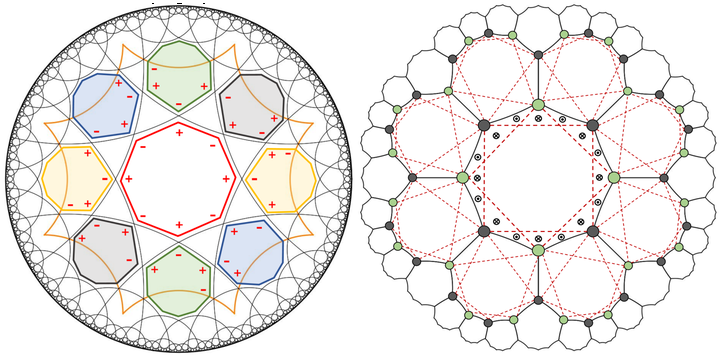
Abstract
The physics of negatively curved (hyperbolic) geometry has experienced a large resurgence of interest in recent years, both theoretically and experimentally. Although hyperbolic spaces constitute a fundamental ingredient in theoretical studies of holography, network optimization, quantum chaos, and of certain many-body techniques, until recently they remained challenging to experimentally realize. The reason is the Hilbert’s theorem: a space with constant negative curvature cannot be embedded in a Euclidean laboratory space. Nevertheless, this has changed with experimental developments in circuit quantum electrodynamics (QED), where researchers have succeeded in simulating simple tight-binding models on two-dimensional hyperbolic lattices with coplanar waveguide resonators [1]. A similar realization was also achieved by electric-circuit networks in Ref. [2]. There, the authors experimentally showed that a negative curvature is visible in the spectral ordering of the eigenmodes in hyperbolic space. Moreover, these electric-circuit network simulations also allow to perform time-resolved measurements, which enable the study of dynamic processes. Another experimental approach to modeling hyperbolic space, namely by coupling an array of atomic ensambles, was developed by a research group at Stanford [3–5], which seeks ways to identify quantum gravity in highly entangled quantum systems. In particular, the group has succeeded in using cold atoms to develop a quantum entangled system with a “tree-like” structure, in which the correlation geometry is decoupled from the spatial embedding of the atoms and the entanglement between the atoms can be controlled. In analogy with the electric-circuit implementation, the control of entanglement allows for simulation of hyperbolic tessellations; however, this methods supersedes electric circuits in naturally hosting quantum rather than classical states.
Motivated by these experimental developments, a Bloch-like theory of single-particle states on hyperbolic lattices has recently been developed, known as hyperbolic band theory. Specifically, this method provides us with the ability to compute the Bloch Hamiltonian and thus perform an analysis of the band structures of tight-binding models on certain hyperbolic tessellations. The study of lattices compatible with hyperbolic band theory has already been established in Ref. [6] and thus lays the basis of hyperbolic crystallography. However, the validity of the theory is still an open question. For instance, the appearance of higher-dimensional irreducible representations in the translation group is an indication of the incompleteness of hyperbolic band theory. A first analysis of these observations has already been presented in Ref [7].
Inspired by the experimental progress with hyperbolic lattices as well as by the development of theoretical tools to characterize their spectra, we here consider additional ingredient to the physics of negatively curved spaces, namely topology, which has over the past two decades led to fruitful revolution within the condensed matter physics research. Recall that the classification of distinct phases of matter in connection with the study of the underlying band structure has always been a central topic in condensed matter physics. Moreover, the discovery of the quantum Hall effect in 1980 by von Klitzing et al. [8] marked the birth of a whole new branch: the study of topological band theory. In particular, it foreshadowed the research of topological insulators in Euclidean space which, unlike trivial insulators, exhibit localized electrons in the bulk while carrying electric currents on the edges. In this sense, the material has an insulating bulk but metallic edges, where boundary-localized states facilitate the quantized Hall conductance. Additionally, the bulk states can be characterized by a topological invariant, nowadays called the Chern number, and the work of Ref. [9] related this invariant to the presence of the quantized edge currents. Furthermore, Haldane made in Ref. [10] the crucial realization that a nontrivial Chern number and its associated quantum Hall physics can also arise in certain antiferromagnetic insulators in the absence of externally applied magnetic fields. Another attempt in this field was made in 2005 by Kane and Mele, who in Ref. [11] predicted the existence of topological insulators that do not require the breaking of time-reversal symmetry.
This work lies at the confluence of the ideas of hyperbolic geometry and topological phases. Specifically, we ask how many states are lost (and how much physics is reproduced) by considering only the hyperbolic band theory. Although it is known that the Abelian HBT is not a complete theory, quantitative estimates of its (in)completeness are presently missing. Furthermore, we ask whether the theoretical progress allows us to define a topologically non-trivial insulator on a hyperbolic lattice. Although the existence of hyperbolic topological insulators was recently pondered (and heuristically analyzed) in the work of Ref. [12], that work lacked the theoretical insights that are presently available to us, allowing to perform a more rigorous analysis of the prospective topological phases.
The proposed master thesis is structured as follows: In section 2 we introduce the reader to the basic concepts of two-dimensional hyperbolic lattices by reviewing their geometrical aspects, symmetry groups, as well as the recently formulated hyperbolic band theory. In Sec. 3 we discuss some Euclidean topological insulator models and introduce the mathematical tools to study their topological band structure. Specifically, we focus on the “half-BHZ” model, Haldane’s tight-binding system with next-to-nearest neighbor hopping, and the extension to the Kane-Mele time-reversal symmetric approach. Armed with the basic concepts used throughout the thesis, in Sec. 4 we turn our attention to the verification of the (in)completeness of the hyperbolic band theory. Finally, in Sec. 5 we systematically construct a topological insulator model on a two-dimensional hyperbolic lattice. In particular, we develop a hyperbolic counterpart to both the time-reversal Haldane-Chern insulator and the time-reversal symmetric Kane-Mele insulator, and collect evidence of the topological nature of their metallic in-gap states. We conclude with outlooks and further open questions for prospective future work in Sec. 6, and provide supplementary information about the adopted numerical techniques and Mathematica code in the Appendix 7.